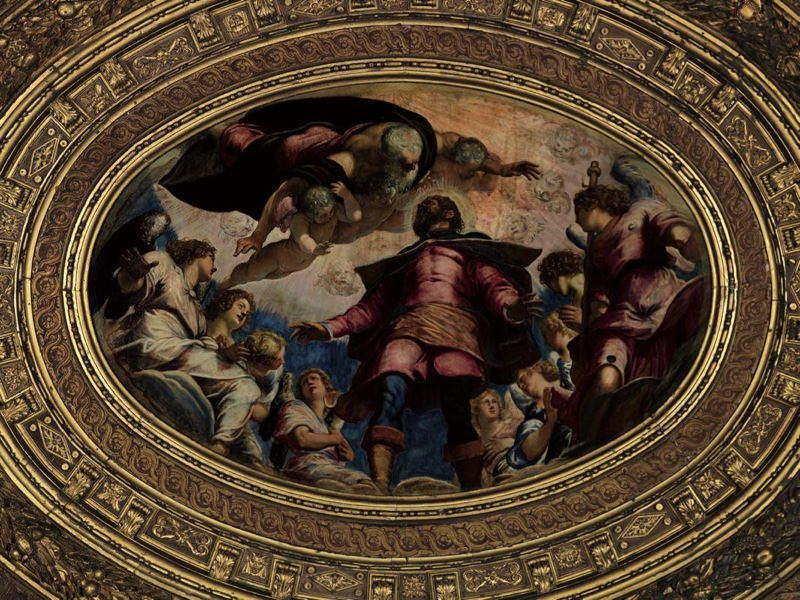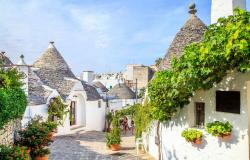Scuola Grande di San Rocco: A Venetian Masterpiece
ITA:

Use player to listen to Italian version
Celebrations for the 500th anniversary since the birth of Tintoretto (1519-2019), one of the leading painters in Venice in the Renaissance, are scheduled to begin later this year, but you don’t need to wait until a major international exhibition dedicated to him opens in September to become familiar with this artist, who was born in Venice, and in Venice lived and worked most of his life.
Some of Tintoretto’s finest work is housed in the Scuola Grande di San Rocco (less than ten minutes from the train station), which some describe as ‘the Sistine Chapel of Venice,’ for the number of characters, colors, figures, shapes and stories from the Old and New Testament depicted by Tintoretto on the walls and ceilings of the rooms of this building, which was originally established as a confraternity in 1478 and named after San Rocco, a venerated saint regarded as a protector against plague and illnesses.
In Renaissance Venice, there was a lot of competition among artists and the way Tintoretto managed to be assigned the task of decorating the Scuola di San Rocco is proof of his volcanic personality (which earned him the nickname of ‘il furioso’, the furious one): when, in 1564, a contest was called to complete the ceiling of one of the rooms, Tintoretto didn’t just present a sketch like his competitors, he prepared the completed painting and had it mounted precisely on the ceiling where it was to go. He then gave it to the Scuola for free. His audacity worked: he was later assigned the entire decoration of the Scuola.
Executed between 1564 and 1587, Tintoretto’s works (27 in the Sala dell’Albergo, eight in the Sala Terrena, 25 in the Sala Superiore), seem carved in light and convey an energy that leaves breathless.
Le celebrazioni per il cinquecentesimo anniversario dalla nascita di Tintoretto (1519-2019), uno dei più importanti pittori a Venezia nel Rinascimento, inizieranno verso la fine dell'anno, ma non è necessario aspettare che una grande mostra internazionale a lui dedicata venga inaugurata a settembre per conoscere meglio questo artista, nato a Venezia, dove visse e lavorò per la maggior parte della sua vita.
Alcune delle opere più belle del Tintoretto sono ospitate nella Scuola Grande di San Rocco (a meno di dieci minuti dalla stazione ferroviaria), che alcuni descrivono come ‘la Cappella Sistina di Venezia’, per il numero di personaggi, colori, figure, forme e storie dal Vecchio e Nuovo Testamento raffigurati da Tintoretto sulle pareti e sui soffitti delle stanze di questo edificio, che fu originariamente costruito come confraternita nel 1478, e intitolato a San Rocco, un santo venerato considerato protettore contro la peste e le malattie.
Nella Venezia rinascimentale, c'era molta concorrenza tra gli artisti e il modo in cui Tintoretto riuscì a farsi assegnare il compito di decorare la Scuola di San Rocco è prova della sua personalità vulcanica (che gli valse il soprannome di ‘il furioso’): quando, nel 1564, fu convocato un concorso per completare il soffitto di una delle stanze, Tintoretto non si limitò a presentare uno schizzo come i suoi concorrenti, preparò il dipinto completo e lo fece incastonare sul soffitto dove sarebbe dovuto apparire. Poi lo regalò alla Scuola. La sua audacia funzionò: in seguito gli fu assegnata l'intera decorazione della Scuola.
Eseguite tra il 1564 e il 1587, le opere del Tintoretto (27 nella Sala dell'Albergo, otto nella Sala Terrena, 25 nella Sala Superiore), sembrano scolpite nella luce e trasmettono un'energia che lascia senza fiato.











